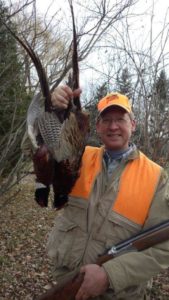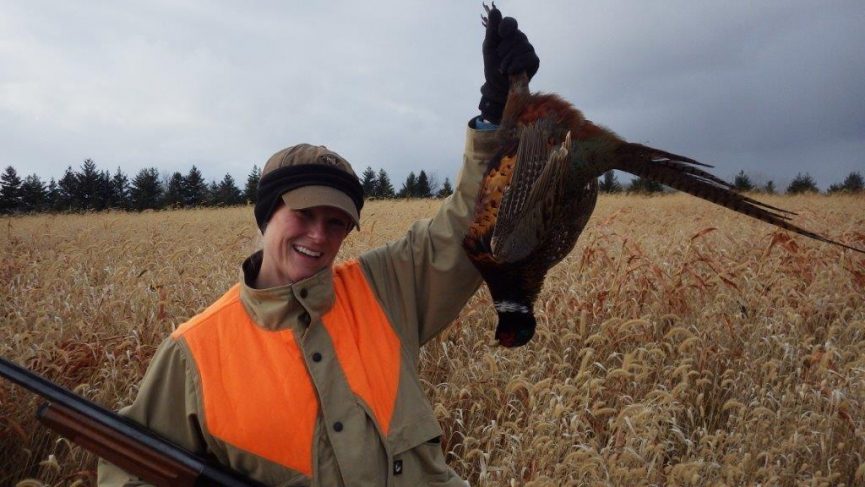
Pheasants Forever, Michigan, Bill Vander Zouwen
Featured Pic (above): Dr. Kelly Straka is the new MDNR Wildlife Division Veterinarian and is proof positive ladies love to hunt wild pheasants too. Her favorite shotgun for wild Thumb roosters this past December is a semi-automatic 12 ga. The MDNR places a strong focus on pheasant (and small game) hunting in Michigan.
By: Tom Lounsbury.
The pheasant’s history in Michigan is relatively short when you figure overall events in century form. I’m always amazed by the amount of folks today who believe the pheasant is an indigenous (native) wild bird species to North America. The reality is that the pheasant is indigenous only to Asia, from Siberia to Burma with distinct types (races) according to the region. The Romans are credited, thanks to trade with the East, in bringing the pheasant to mainland Europe and the British Isles. This was due to the fact the pheasant was looked upon as a culinary delight (and not a game bird) and was mainly transported around by the Romans for this reason (just like chickens and other fowl).
The pheasant belongs to the order Galliformes which includes chickens, peacocks, grouse and turkeys, so it is definitely good to eat, as well as the roosters are quite colorful. On estates in Europe and the British Isles during the Middle Ages, the pheasant was looked upon not only as a culinary delight, but also as a lawn ornament of sorts. Of course the pheasant truly has a free spirit and plenty would escape to adapt and propagate in the wild. This is when it would begin its status as a game bird especially when firearms came into the picture for hunting, and wing-shooting came into being (flintlock firearms used in those earlier times were known as fowling pieces or “fowlers” – I took some “buckskinners” pheasant hunting on my farm last October who used such).
Attempts were made to establish the pheasant in Colonial America (1700s) with birds from England, but proved to be unsuccessful. In 1881, a former Ambassador to China who had developed a taste for pheasant had a number shipped from China to his home state of Oregon. This time, no doubt due to ideal habitat combined with continuous ideal weather, the transplant eventually took hold in a big way. Oregon held the first official pheasant season in North America in 1889, with over 50,000 birds being harvested on the opening day.
This news would reach sportsmen across the nation who in turn would want their states to follow Oregon’s example. Of course Oregon’s pheasants were true “Chinese Ring-Necks” direct from China. Pheasants east of the Mississippi can trace their lineage to eastern game farms (that obtained the original eggs from the British Isles). The bloodlines here would definitely feature the Chinese Ring-Neck (due to the distinctive white ring around roosters’ necks), but also some other races as well. The proper name for the mixed-blood pheasants being released in the eastern states, including Michigan, is simply “ring-necked pheasants”.
The Michigan Conservation Department would begin a large pen-rearing and pheasant release program for parts of southern Michigan (including the Thumb) in 1917. The habitat at that time provided just what these pheasants required, and there were most likely fewer predators thanks to farmers and their kids who enjoyed hunting and trapping (and birds of prey were also looked ill upon). At that time a majority of Americans depended upon agriculture for their livelihoods, offering lots of brushy fencerows, farm lanes and pastures. Pen-reared pheasants aren’t the “sharpest tools in the shed”, so to speak especially when it comes to predators, so fewer predators meant a higher survival rate of birds being released. The offspring of the pen-reared survivors are what became known (actually evolved) as truly wild pheasants.
Possibly following Oregon’s example of waiting 8 years, Michigan held its first official pheasant season on October 15, 1925. Pheasant hunting in southern Michigan would immediately become extremely popular and pheasant hunter numbers far exceeded deer hunter numbers during the heyday of pheasant hunting. During this heyday southern Michigan’s quality of pheasant hunting was known as being among the best in the country, with the Thumb being a particular hotspot.
My late father was born in 1913 and grew up on a Thumb farm (and became a farmer as well). He witnessed the release of pheasants, as well as the closed period where wild pheasants propagated to the point of becoming looked upon as pests. According to my father, he could remember pheasants pecking freshly planted corn from the ground, and tree limbs being busted down in the orchard due to too many pheasants trying to roost at night on the same limb. At age 12, my father took part in the first Michigan pheasant season, and it would be a pastime he would pursue annually for the next 40 years. He quite literally experienced Michigan’s pheasant hunting heyday, and like many hunters of his day, pheasant hunting was his major outdoor pastime (the Thumb didn’t have its first deer season until 1948, and even then there wasn’t that many deer in these parts – most deer hunters went “up north”).
In order to allow farmers to have the chores done and be able to participate, the Michigan pheasant hunting didn’t start up until 10:00 in the morning. It would also be switched from October 15 to October 20 for opening day in order to allow more time for harvesting certain crops. This change would occur in 1952 and that was a very memorable day for me. Being three years old, it was the first time I was allowed to venture out into the field, thanks to my late mother who was an avid pheasant hunter. We stayed back a bit and flanked the long line of hunters and dogs, and targeted roosters which escaped the shooting barrage and sailed over in our direction and landed close by.
I was my mother’s “pooch” in putting up roosters we had marked, and I retrieved the birds she dropped with her single-shot Iver-Johnson 20ga, and it usually didn’t take Mom long to get her 2-rooster limit. I would eventually start carrying a shotgun too (a single-shot .410) at an early age that might surprise some folks, but I was also carrying my weight (as light as it was) on the farm. I will always remember those opening days when schools were closed for the occasion and our farmyard looked like a parking lot at the county fair. I loved the entire atmosphere of hunters, dogs, cackling roosters, gunfire and that unique smell of freshly burnt gunpowder on a brisk autumn wind.
I feel quite blessed to have been a Thumb area farm kid during the pheasant heyday of the 1950’s and early 1960’s. Then a “crash” would occur, when pheasant numbers plummeted in an abrupt manner. Bad winters involving ice storms (ice storms are very hard on pheasants) and lots of snow were a key influence, and new farming techniques were also evolving and habitat once always available suddenly disappeared. With far fewer pheasants, far fewer hunters came to the Thumb to hunt them, and much to my dismay schools remained open on October 20. The heyday was over, and with my parents’ blessing, I played hooky from school every October 20, and I never gave up on local pheasant hunting.
For more than 30 years now, I’ve been a volunteer for the MDNR to count roosters crowing at daybreak on a specific route in the Thumb during the month of May. This is timed with the pheasant spring breeding period and my route has given me a keen insight into pheasant numbers in relation to continually changing habitat. Sites which featured a high number of roosters one spring due to a government grassland program would have zero roosters the following year due to the land being put back into crop production. So the wild pheasant’s future in the Thumb is closely tied to government grassland programs and other habitat related efforts.
A positive thing for pheasants today is the Michigan Pheasant Restoration Initiative (MPRI). This is where landowners form a co-op with a focus on pheasant habitat and help each other out as well as share ideas. It is something I hope to help in getting started in my neighborhood soon. MPRI also puts “boots on the ground” in the form of skilled wildlife biologists who can assist the co-ops, as well as folks in a grassland program. For the Thumb, this is Jason Myers who I’ve discovered really knows what he is talking about (he can be reached at 989-673-8174, Ext 3). Jason has been an invaluable aid in my habitat endeavors.
When my wife Ginny and I purchased the family farm (I’m the 4th generation) in 2001, we immediately enrolled the majority of it into various government grassland (and windbreak) programs, and we love every bit of the atmosphere that now surrounds us. I’m continually asked by folks who observe pheasants on our ground if I plant any pen-reared birds, and the answer is, no I do not. As a kid, I hunted the wild ancestors of the wild birds I hunt today, which is testimony to the fact that the pheasant can be tough and resilient when given a fair chance with proper habitat. Yes folks, pheasant hunting is still alive and well in the Thumb.

